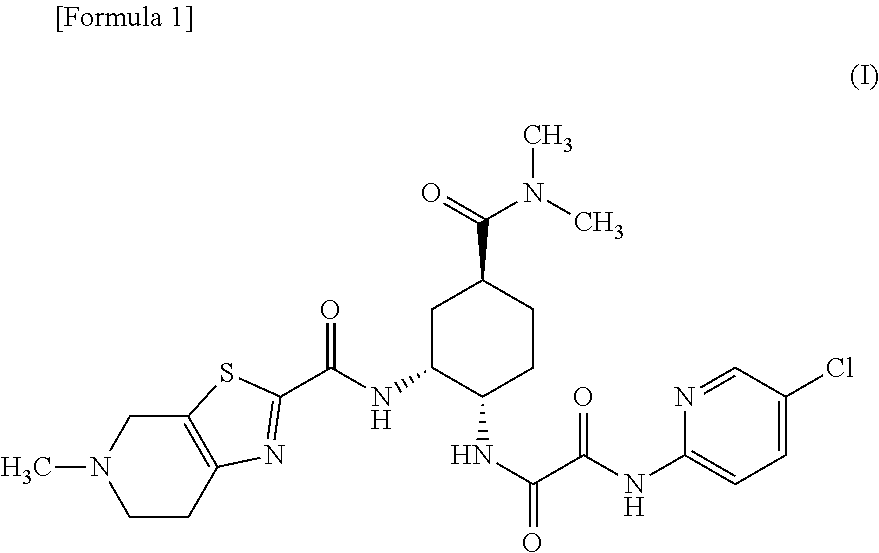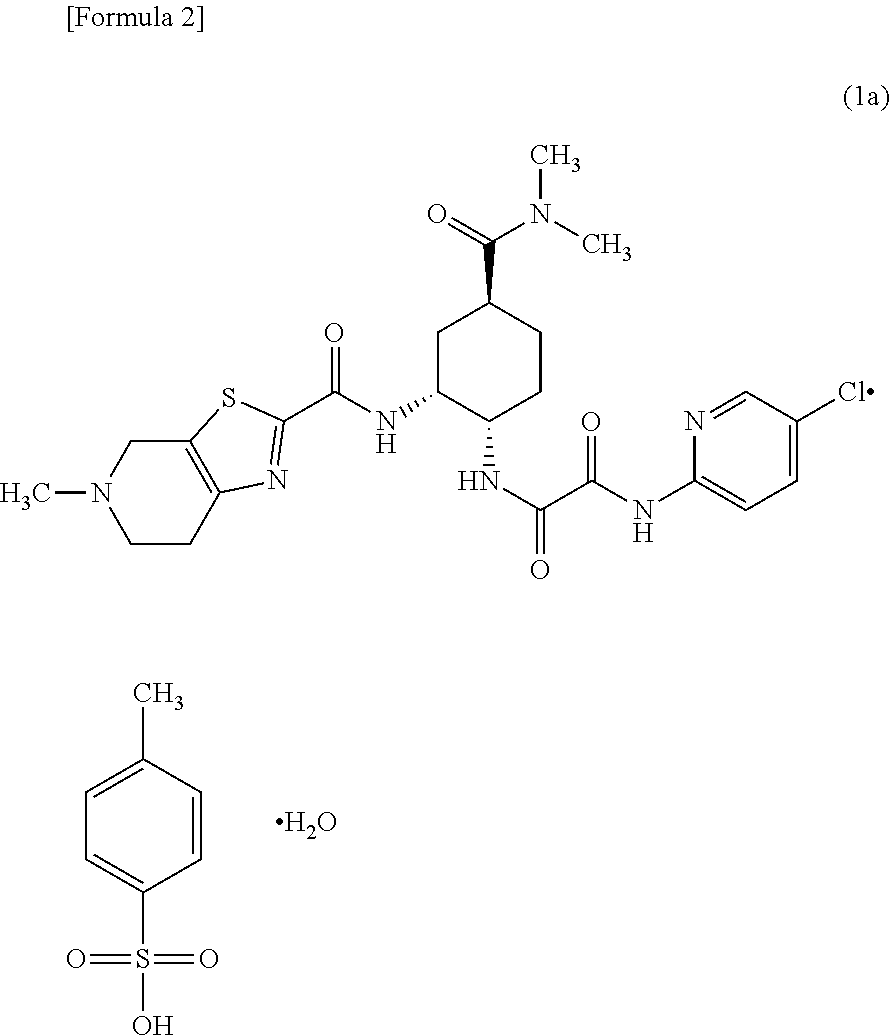Preventive and/or therapeutic agent for thromboembolism in thromboembolism patient with severe renal impairment
a technology for thromboembolism and thromboembolism patients, which is applied in the field of preventive and/or therapeutic agents for thrombosis and/or embolism in thrombosis and/or embolism patients with severe renal impairment, can solve the problems of increasing achieve effective prevention of thrombosis and/or embolism, avoid the risk of bleeding, and effectively prevent thrombosis and/or embolism with safety
- Summary
- Abstract
- Description
- Claims
- Application Information
AI Technical Summary
Benefits of technology
Problems solved by technology
Method used
Image
Examples
example 1
Late Phase-II Trial Targeting NVAF Patient in Japan
[0059]In Japan, edoxaban 30 mg×1 / day, edoxaban 45 mg×1 / day, or edoxaban 60 mg×1 / day, or warfarin (whose PT-INR was adjusted to 2.0 to 3.0 (1.6 to 2.6 for 70 years or older)) was orally administered for 12 weeks to each of 519 NVAF patients to evaluate the incidence of thromboembolic events and the incidence of bleeding events.
[0060]The only thromboembolic event was one cerebral infarction that occurred in one subject in the edoxaban 45 mg group.
[0061]Major bleeding occurred in 3 subjects (2.2%) in the edoxaban 45 mg group and 2 subjects (1.5%) in the edoxaban 60 mg group. The incidence of major bleeding or the incidence of major bleeding or clinically relevant non-major bleeding was not statistically significantly different between the warfarin group and each edoxaban group. Likewise, no significant difference was seen in the paired comparison among the edoxaban groups. In addition, a statistically significant dose-response relation...
example 2
Phase-III Trial Targeting NVAF Patient with Severe Renal Impairment
Clinical Trial Protocol
[0066]After obtaining consent from the subject for participation in the study, his / her CLCR values were calculated using to the Cockcroft-Gault equation at screening to evaluate the renal function of the subject to confirm that he / she was a NVAF patient with severe renal impairment (SRI) (CLCR: 15 mL / min or higher but lower than 30 ml / min (except for hemodialysis patients)) or with normal renal functions or mild renal impairment (MiRI) (CLCR: 50 mL / min or higher). The subjects were enrolled to the study after further examination to confirm he / she fulfilled the inclusion / exclusion criteria.
Cockcroft-Gault Equation
[0067]
For male: {(140−age)×body weight (kg)}÷{72×serum creatinine level (mg / dL)}
For female: [{(140−age)×body weight (kg)}÷{72×serum creatinine level (mg / dL)}]×0.85
[0068]Subjects with SRI and NVAF received 15 mg of edoxaban once a day for 12 weeks. subjects with normal renal functions an...
example 3
A Phase 3, Randomized, Double-Blind, Double-Dummy, Parallel Group, Multi-Center, Multi-National Study for Evaluation of Efficacy and Safety of Edoxaban (DU-176b) versus Warfarin In Subjects With Atrial Fibrillation—Effective Anticoagulation With Factor Xa Next Generation in Atrial Fibrillation (ENGAGE—AF TIMI—48)
[0079]A randomized, double-blind, double-dummy trial comparing two once-daily regimens of edoxaban with warfarin in 21,105 patients with moderate to-high-risk atrial fibrillation (median follow-up, 2.8 years) was conducted. Patients were randomly assigned, in a 1:1:1 ratio, to receive warfarin, dose-adjusted to achieve an international normalized ratio (INR) of 2.0 to 3.0, or to receive high-dose or low-dose edoxaban. The high-dose edoxaban group received 60 mg, and the low-dose group 30 mg. For patients in either group, the dose was halved if any of the following characteristics were present at the time of randomization or during the study: estimated creatinine clearance of...
PUM
| Property | Measurement | Unit |
|---|---|---|
| Time | aaaaa | aaaaa |
| Mass | aaaaa | aaaaa |
| Volumetric flow rate | aaaaa | aaaaa |
Abstract
Description
Claims
Application Information
 Login to View More
Login to View More - R&D
- Intellectual Property
- Life Sciences
- Materials
- Tech Scout
- Unparalleled Data Quality
- Higher Quality Content
- 60% Fewer Hallucinations
Browse by: Latest US Patents, China's latest patents, Technical Efficacy Thesaurus, Application Domain, Technology Topic, Popular Technical Reports.
© 2025 PatSnap. All rights reserved.Legal|Privacy policy|Modern Slavery Act Transparency Statement|Sitemap|About US| Contact US: help@patsnap.com


